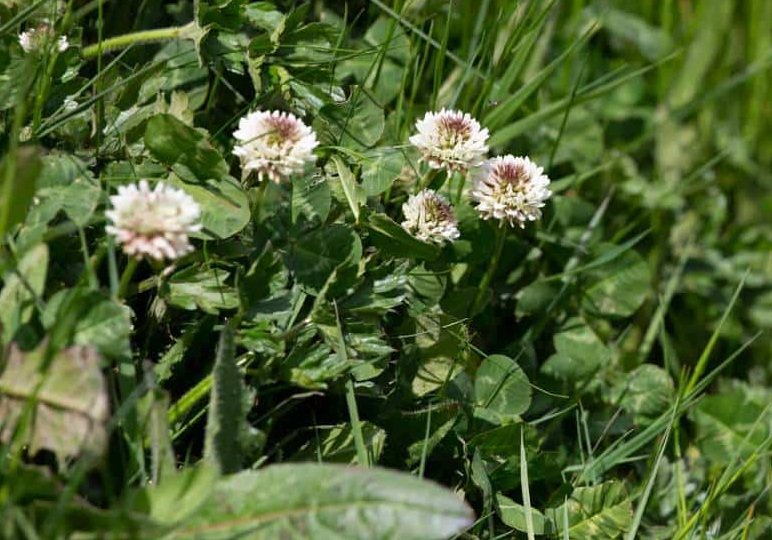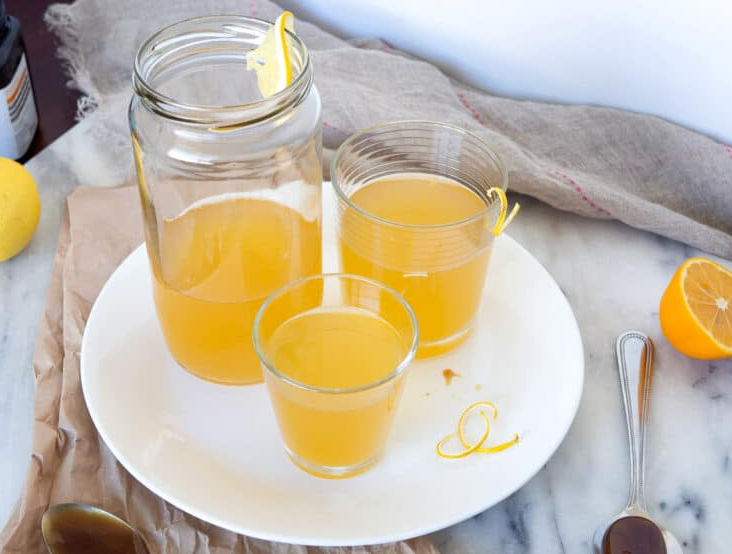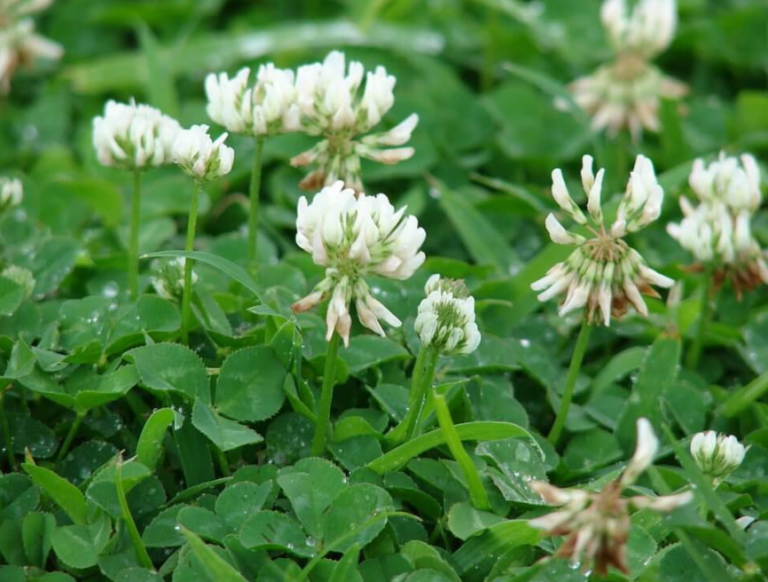White clover, a common weed with delicate white flowers, is more than a beautiful addition to lawns and gardens. It is a versatile plant with a long history of medicinal use and a growing reputation for its health benefits.
White clover (Trifolium repens) is a widespread and familiar plant, thriving in lawns, meadows and even cracks in sidewalks. Its small, white flowers are a familiar sight in spring and early summer. Beyond its ornamental appeal, white clover is a source of several beneficial compounds, including:
- Antioxidants: White clover contains a variety of antioxidants, including flavonoids and polyphenols, which help protect cells from damage caused by free radicals.
- Anti-inflammatory properties: White clover has been shown to possess anti-inflammatory properties, potentially making it helpful in managing inflammation-related conditions.
- Immune system support: White clover may contribute to a healthy immune system by boosting antioxidant activity and supporting overall inflammatory response.
How to Make White Clover Tea?
In recent years, herbal teas have gained significant popularity, replacing traditional caffeinated beverages such as black tea and coffee. White clover tea stands out among these herbal infusions with its unique flavor and potential health benefits.
The tea has a light, delicate taste, reminiscent of honey and clover blossoms, with a slightly sweet and floral aroma. This delicate flavor profile makes it a refreshing and enjoyable drink, suitable both hot and cold.
Preparing White Clover Tea
White clover tea is simple to make and can be prepared in various ways:

Method 1: Using Dried White Clover Blossoms
- Gather 1-2 tablespoons of dried white clover blossoms.
- Fill a teapot or mug with hot water (around 200°F)
- Add the dried clover blossoms to the hot water.
- Steep for 5-10 minutes, allowing the flavors to infuse.
- Strain the tea into a cup and enjoy warm or cold.
Method 2: Brewing with Fresh White Clover Blossoms
- Pick fresh white clover blossoms, ensuring they are clean and free from pesticides.
- Fill a teapot or mug with hot water (around 200°F)
- Add a handful of fresh white clover blossoms to the hot water.
- Steep for 5-10 minutes, allowing the flavors to infuse.
- Strain the tea into a cup and enjoy warm or cold.
Method 3: Iced White Clover Tea
- Prepare white clover tea using either dried or fresh blossoms, using the recommended steeping time.
- Once the tea is steeped, allow it to cool down completely.
- Pour the cooled tea into a pitcher and add ice cubes to chill.
- Sweeten with honey, maple syrup, or sugar to taste.
- Garnish with fresh mint or lemon slices for added flavor and presentation.
How to Make Fig Leaf Tea for Diabetics?
Choosing and Harvesting White Clover
Appearance of White Clover
White clover (Trifolium repens) is a small, low-growing plant that thrives in a variety of environments, including lawns, meadows, and fields. It is easily identifiable by its delicate white flowers, pea-like leaves, and slender, branching stems.

Leaves: White clover leaves are arranged in a trifoliate pattern, meaning there are three leaflets on each stem. The leaflets are oval in shape with smooth edges and light green color. They are usually 0.5 to 1 inch long and 0.25 to 0.5 inch wide.
Flowers: White clover flowers are small and clustered in dense racemes, forming a ball-like shape. Each flower has five white petals and a pale green calyx with five teeth. The flowers bloom from spring to fall and are a favorite of pollinators such as bees and butterflies.
Stems: White clover stems are smooth, slender, and slightly hairy. They can grow up to 18 inches long and are branched, forming a mat-like growth. The stems are green in color, turning brown with age.
Harvesting White Clover
The best time to harvest white clover is during its flowering season, which typically runs from spring to early summer. The flowers contain the highest concentration of nutrients and beneficial compounds.
Weather Conditions: Optimal harvesting conditions include sunny days with mild temperatures, preferably between 60°F and 80°F. Avoid harvesting on rainy or humid days, as these conditions can increase the risk of contamination from bacteria or mold.
Time of Day: Early morning is the ideal time to harvest white clover, as the plants are fresh and haven’t been exposed to direct sunlight, which can cause wilting and reduce their quality.
Harvesting from Clean Areas
It is very important to source white clover from clean, uncontaminated sites away from pesticides and herbicides. Pesticide residues can contaminate clover and pose health risks if used. Look for areas of naturally growing clover in fields, meadows or lawns that have not been treated with harsh chemicals.
Alternative Sources of Clover
If you don’t have access to wild white clover or prefer the convenience of pre-prepared products, there are several alternative sources of clover available. These include:
- Organic farms: Many organic farms cultivate white clover and sell it in various forms, including dried flowers, fresh leaves, and even clover-infused honey.
- Reputable herbal shops: Herbal shops and online retailers often carry dried white clover blossoms for use in teas and herbal remedies. Ensure the source is reputable and follows stringent quality control measures.
- Pre-packaged tea blends: Several tea companies offer pre-packaged herbal tea blends containing white clover blossoms. These teas are convenient and offer a consistent flavor profile.
When purchasing white clover from a source other than wild harvesting, it’s essential to check for purity and quality. Look for products with clear labeling that specifies the type of clover (white clover), the harvest source (organic or non-organic), and any processing methods applied.
Preparation Methods

Fresh Clover Tea
Steeping Fresh White Clover Tea
- Gather the Materials: Select fresh white clover blossoms, ensuring they are clean and free from dirt or insects. You can also add other herbs or spices to enhance the flavor and health benefits, such as mint, lemon balm, or ginger.
- Choose the Amount: For a mild infusion, use 1-2 tablespoons of fresh clover blossoms per cup of water. For a stronger flavor, increase the amount to 3-4 tablespoons.
- Steeping Time: Pour hot water (around 200°F) over the clover blossoms and herbs. Cover the teapot or mug and allow the tea to steep for 5-10 minutes, depending on your preference for stronger or milder flavor.
- Strain and Enjoy: Strain the tea into a cup using a fine-mesh strainer or cheesecloth to remove the clover blossoms and herbs. Add honey or other sweeteners to taste, if desired.
Cold Brewing for Refreshment
For a refreshing iced white clover tea, follow the same method but instead of using hot water, steep the clover blossoms and herbs in cold water for at least 4 hours or overnight. This allows the flavors to infuse gradually and produces a lighter, more delicate tea.
Once steeped, strain the tea and chill it in the refrigerator. Serve with ice and add sweetener or flavorings to taste.

Tips for Adding Flavor and Health Benefits
- Mint: Adds a refreshing minty flavor and complements the delicate sweetness of white clover.
- Lemon Balm: Infuses a soothing lemony aroma and flavor, while also offering calming and anti-stress properties.
- Ginger: Adds a warmth and spicy kick to the tea, along with its known anti-inflammatory and antioxidant benefits.
Dried Clover Tea
Benefits of Drying White Clover
- Longer Shelf Life: Dried clover blossoms can be stored for up to a year, extending the availability of this herbal tea.
- Year-Round Enjoyment: Dried clover blossoms can be enjoyed throughout the year, regardless of the flowering season.
- Concentration of Flavor: Drying concentrates the flavor of the clover blossoms, resulting in a more intense infusion in tea.
- Portability: Dried clover blossoms are lightweight and compact, making them easy to carry for on-the-go enjoyment.
Drying Methods
- Air Drying: Spread the clover blossoms on screens or trays in a well-ventilated, shaded area away from direct sunlight. Allow the blossoms to dry completely, which may take several days or weeks, depending on the weather conditions.
- Oven Drying: Preheat the oven to its lowest setting, around 150°F. Spread the clover blossoms in a single layer on a baking sheet lined with parchment paper. Dry the blossoms for 2-3 hours, checking them periodically to ensure they don’t burn.
- Dehydrator: Use a food dehydrator set to its lowest temperature, typically around 115°F. Spread the clover blossoms evenly on dehydrator trays and dry for 2-3 hours, or until completely dry.
Storing Dried Clover
- Airtight Containers: Transfer the dried clover blossoms to airtight containers, such as glass jars or resealable plastic bags.
- Dark and Cool Storage: Store the containers in a cool, dark place, away from direct sunlight and heat sources. Avoid storing the clover in the refrigerator, as it can absorb moisture and become moldy.
Tips for Proper Storage:
- Ensure the clover blossoms are completely dry before storing to prevent mold growth.
- Label the containers with the date of drying and the contents to ensure proper identification.
- Use the clover blossoms within a year of drying for optimal freshness and flavor.
Clover Tea Infusions
Infusing clover into oils, vinegar, or honey is a simple yet effective way to impart its delicate flavor and potential health benefits into various culinary creations. These infused ingredients can be used to enhance the taste of salads, marinades, dressings, sauces, and even baked goods.
Oil Infusion
- Gather Materials: Choose high-quality olive, canola, or another neutral-flavored oil. Ensure the oil is of the highest quality to prevent rancidity and maintain its flavor.
- Sanitize Vessel: Wash and dry a glass jar or bottle thoroughly to prevent contamination.
- Fill with Clover: Pack the jar or bottle with dried clover blossoms, ensuring they are evenly distributed and not compacted. Leave some headspace at the top of the jar.
- Pour Oil: Slowly pour the oil into the jar, ensuring the clover blossoms are completely submerged.
- Close Tightly: Seal the jar tightly to prevent air from entering and oxidation of the oil.
- Infuse: Place the jar in a cool, dark place for at least 2-3 weeks, shaking the jar occasionally to circulate the oil and evenly distribute the clover flavor.
- Strain and Store: After the desired infusion time, place a fine-mesh strainer or cheesecloth over a clean jar or bottle. Slowly pour the infused oil through the strainer, discarding the clover blossoms.
- Store Refrigerated: Store the infused oil in the refrigerator for up to 3 months for optimal flavor and quality.
Vinegar Infusion
- Choose Vinegar: Select white wine vinegar, apple cider vinegar, or another vinegar with a mild flavor to complement the clover’s delicate taste.
- Sanitize Vessel: Wash and dry a glass jar or bottle thoroughly to prevent contamination.
- Pack with Clover: Fill the jar or bottle with dried clover blossoms, ensuring they are evenly distributed and not compacted. Leave some headspace at the top of the jar.
- Pour Vinegar: Carefully pour the vinegar into the jar, ensuring the clover blossoms are completely submerged.
- Close Tightly: Seal the jar tightly to prevent air from entering and oxidation of the vinegar.
- Infuse: Place the jar in a cool, dark place for at least 2-3 weeks, shaking the jar occasionally to distribute the clover flavor evenly.
- Strain and Store: After the desired infusion time, place a fine-mesh strainer or cheesecloth over a clean jar or bottle. Slowly pour the infused vinegar through the strainer, discarding the clover blossoms.
- Store in a Cool Place: Store the infused vinegar in a cool, dark place away from direct sunlight for up to 6 months for optimal flavor and quality.
Honey Infusion
- Choose Honey: Select clover honey, if available, for a more concentrated flavor. Otherwise, use another mild-flavored honey, such as wildflower or lavender honey.
- Sanitize Vessel: Wash and dry a glass jar or bottle thoroughly to prevent contamination.
- Add Clover Blossoms: Fill the jar or bottle with dried clover blossoms, ensuring they are evenly distributed.
- Pour Honey: Slowly pour the honey into the jar, ensuring it completely covers the clover blossoms.
- Close Tightly: Seal the jar tightly to prevent air from entering and moisture loss from the honey.
- Stir and Store: Gently stir the honey and clover blossoms to distribute the flavor evenly. Store the jar in a cool, dark place away from direct sunlight for up to 6 months for optimal flavor and quality.
Safety and Sanitation
- Always use clean, sanitized utensils and containers to prevent contamination.
- Do not use clover blossoms that are moldy, discolored, or have an unpleasant odor.
- Store infused oils, vinegar, or honey in airtight containers to prevent oxidation and contamination.
- Consume infused ingredients within their recommended shelf life for optimal quality and flavor.
Brewing Tips and Variations

Optimal Water Temperature and Steeping Time
The ideal water temperature for white clover tea is around 200°F (93°C). This temperature ensures that the delicate flavors and beneficial compounds are extracted from the clover blossoms without scalding them and imparting a bitter taste.
The steeping time also affects the strength and flavor of the tea. For a mild infusion, steep the tea for 5-7 minutes. For a stronger flavor, steep for 7-10 minutes.
Equipment Options for Brewing White Clover Tea
- Teapot: A classic teapot is a versatile choice for brewing white clover tea. Choose a teapot made from porcelain or ceramic, as these materials won’t impart any flavors to the tea.
- Infuser: An infuser allows you to steep the clover blossoms without having to remove them from the teapot or mug. This can be convenient for preserving the delicate flowers and adding a visual element to your tea.
- French Press: A French press is another effective method for brewing white clover tea. It allows for complete immersion of the clover blossoms, resulting in a strong and flavorful infusion.
Creative Variations on White Clover Tea
- Iced White Clover Tea: For a refreshing summertime beverage, steep white clover tea as usual and then chill it in the refrigerator. Serve with ice and add sweetener or flavorings to taste, such as honey, citrus slices, or mint sprigs.
- Clover Tea Cocktails: White clover tea can be incorporated into cocktails to add a hint of sweetness and delicate floral notes. Try blending it with gin, vodka, or sparkling wine, and garnish with mint or lemon.
- White Clover Tea with Honey or Other Sweeteners: Sweeten your white clover tea to your liking. Honey is a traditional choice, but you can also use maple syrup, sugar, or agave nectar. Experiment with different sweeteners to find your favorite combination.
Health Benefits and Considerations

White clover tea has been traditionally used for its potential health benefits, although more research is needed to confirm these effects. These potential benefits include:
- Antioxidants: White clover contains a variety of antioxidants, which may help protect cells from damage caused by free radicals.
- Anti-inflammatory properties: White clover has been shown to have anti-inflammatory properties, potentially making it helpful in managing inflammation-related conditions.
- Immune system support: White clover may contribute to a healthy immune system by boosting antioxidant activity and supporting overall inflammatory response.
If you have any underlying health conditions or are taking medications, it is always advisable to consult with a healthcare professional before consuming white clover tea. They can assess your individual needs and determine if white clover tea is appropriate for you.
Moderation and Responsible Consumption
It is important to consume white clover tea in moderation, as excessive consumption may lead to adverse effects. Stick to the recommended steeping times and serving sizes.
What to do with Used Tea Leaves?
Conclusion
Delicious and easy to prepare, white clover tea is a versatile and refreshing drink with a subtle floral aroma and hint of sweetness. Whether you prefer the delicate flavor of fresh clover flowers or the concentrated infusion of dried clover, white clover tea is a simple and enjoyable way to incorporate the goodness of nature into your day.
Experiment with different cooking methods, such as soaking in hot water or adding oil or vinegar, to find your favorite way to bring out the flavor. With its potential health benefits and delicate charm, white clover tea is a delightful addition to your herbal tea collection.
Resources & References
- “White Clover: A Versatile and Beneficial Herbal Tea” by Healthline (https://www.healthline.com/nutrition/is-clover-edible)
- “White Clover Tea: Benefits, Preparation, and Recipes” by The Spruce Eats (https://www.growforagecookferment.com/white-clover-iced-tea/)
- “White Clover Tea: A Guide to Preparation and Uses” by Herbal Academy (https://theherbalacademy.com/student-dashboard/)
- “Harvesting White Clover for Tea and Infusions” by Edible Upland Forest (https://www.outdoorhappens.com/gathering-your-own-red-clover/)
- “When to Harvest White Clover for Tea” by The Spruce Eats (http://www.laurieconstantino.com/how-to-harvest-spruce-tips-with-recipes-for-using-spruce-tips-or-pine-tips-or-fir-tips/)
- “How to Harvest White Clover” by Mountain Rose Herbs (https://www.youtube.com/watch?v=ZMKWKtpXPC8)
- “Drying White Clover for Tea and Other Uses” by The Spruce Eats (https://mamaonthehomestead.com/preserving-white-clover/)
- “How to Dry White Clover: A Step-by-Step Guide” by Mountain Rose Herbs (https://blog.mountainroseherbs.com/)
